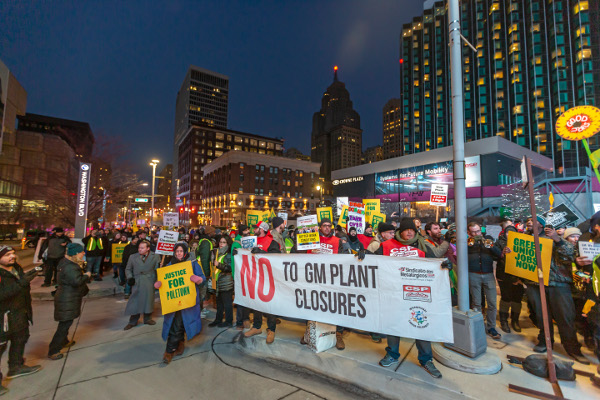
close five Michigan plants.
PHOTO/JIMWESTPHOTO.COM
DETROIT, MI — “In 1937, 45,000 people worked for GM in Flint. That number grew to 80,000 in 1978. By 2010, only 8,000 people had a job with GM in Flint.
“In 1979, about 1 million members of the United Auto Workers (UAW) worked in the auto-industry in this country. Today around 140,000 UAW members work in the auto-industry in the United States.
“Since 1979, 267 (60%) auto plants have closed in this country. Of those plant closings, 173 occurred in Michigan and 19 of those closed plants were in Flint.” (“From Sit-Down Strike to Lead Poisoning”)
On Monday November 26, 2018, GM announced that it was not scheduling any future production at five of its factories beginning in 2019. The current UAW contract with GM, Ford and Chrysler expires in 2019 and the current CAW contract expires in 2020.
Three of the factories make cars and two of the factories make transmissions. The car factories are in Michigan, Ohio, and Ontario. The transmission factories are in Michigan and Maryland.
Plant closings are not a new phenomenon. Flint, as pointed out above, is in ruins today as a result of plant closings.
The Detroit-Hamtramck plant was opened in 1985 and straddles both Detroit and Hamtramck. As a result of the Detroit-Hamtramck opening, the Fleetwood and Cadillac plants in Detroit were closed in 1987.

The Detroit-Hamtramck plant was the result of Chrysler closing its Dodge Main plant in 1979 as a result of the “oil crisis” in the mid-1970s. The 69-year-old plant occupied 67 acres and was located at the fringes of the eastern and southern borders of Hamtramck with Detroit. The “Dodge Main” plant was to be demolished along with the destruction of the Detroit neighborhood north of I-94 and south of Hamtramck and resulting in 532 acres of land dedicated to the GM plan for their new plant.
“It was a simple enough plan, the City announced it would essentially clear-cut 465 acres of land in the center of the city—some 1,500 homes, 144 businesses, 16 churches, a school and a hospital—some 3,500 people were forced out—and turn it over to GM who would build a new Cadillac factory that would employ 6,500 workers.” (Poletown Revisited)
In 2004 the Michigan Supreme ruled that the use of Eminent Domain in “Poletown” was illegal!!!
“The Hathcock Court’s decision to overrule Poletown vindicates an important legal principle to protect people from what the founding fathers called “the mischiefs of faction.” It sends a clear message to other courts that the abuse of eminent domain must be stopped, and that the government’s power to seize property must be limited by effective constitutional restraints. This article discusses the background and importance of Hathcock, and some of the important matters that must be addressed to further rein in the extreme government power of eminent domain.” (A Gleeful Obituary for Poletown Neighborhood Council v. Detroit, by Timothy Sandefur)
In other words, GM is one of the factions that control the government. We must take control back. If all else fails, use eminent domain to take those acres given to GM back and do something with them for the public good.
